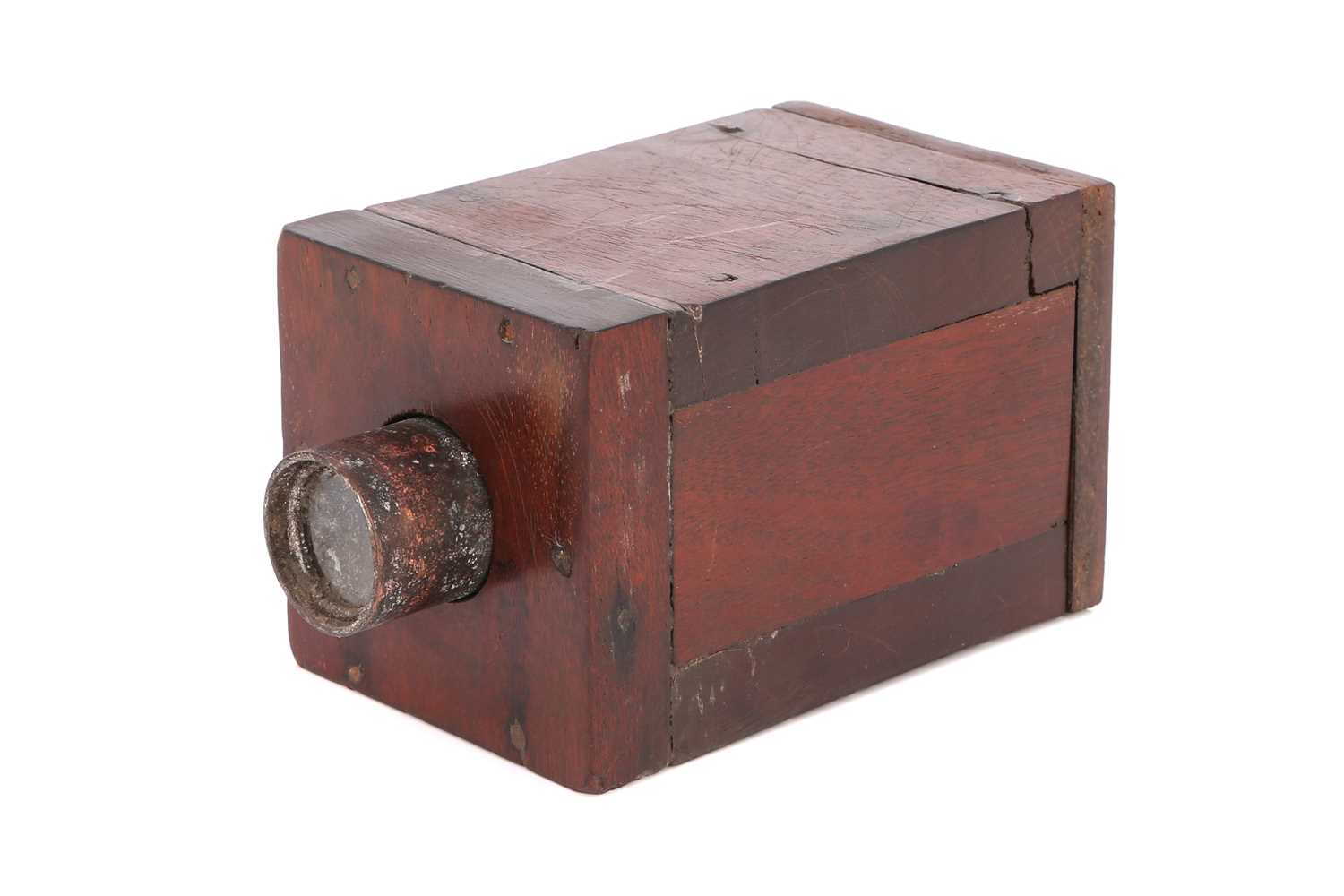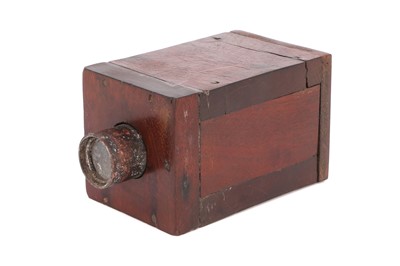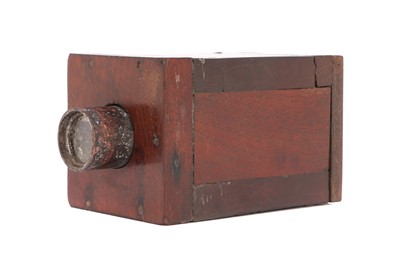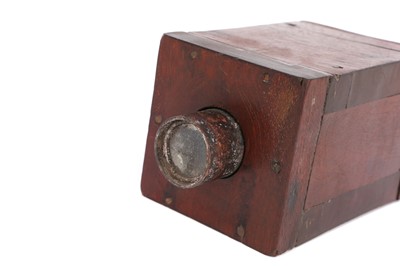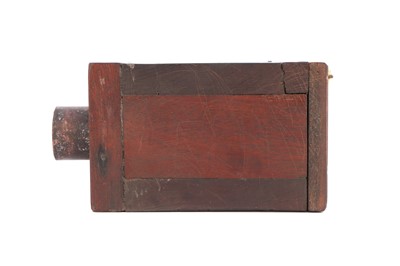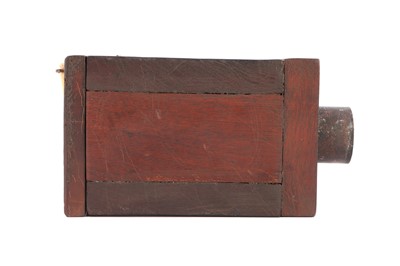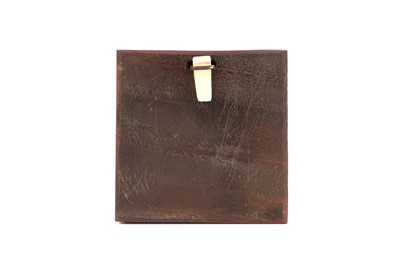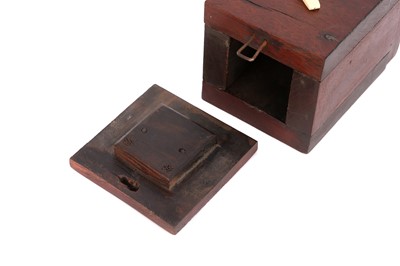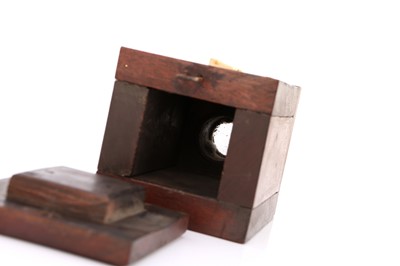19th Nov, 2020 12:00
Fine Photographica & Instruments of Science
An Early Experimental ‘Mousetrap’ Camera
English, c.1840, unsigned, constructed of solid heavy-gauge (15mm thick) mahogany with brass pins through the edges to secure in place, the front lens panel with 6 brass pins to secure, with central aperture holding a brass tube (29mm OD), with a single convex lens held in place with a split ring, to the rear of the camera is a single door held in place with a steel wire loop and bone wedge, the inside of the door has a protruding square of mahogany to which the sensitised paper would have been pinned, to the inside top of the door are multiple holes where the pins were inserted, camera, excluding lens, 11.7cm long x 7.3cm x 7.3cm.
This camera has been studied, photographed and documented by Roger Watson FRSA, Curator of the Fox Talbot Museum as follows;
"An Early Experimental ‘Mousetrap’ Camera
The current owner of this camera brought it to me in 2019 for examination. I knew him and had examined other cameras of his in the past. The size, crudeness of construction and the obvious signs of age indicated to me that this had all the hallmarks of an early experimental camera.
By the end of 1839, optical instrument makers in England, France and the US were making finely finished and well-made cameras for the gentleman artist. Prior to that the earliest experimenters had to make their own cameras and these were usually either a converted camera obscura or, like this one, a simple box with a simple lens in one side. The best-known examples of early experimental cameras are the ‘Mousetrap’ cameras used by William Henry Fox Talbot between 1835 and 1840 for his experiments in photogenic drawing. Though there is nothing to indicate that this example was made by or used by Talbot.
Numerous descriptions of these crude cameras exist from the period. In October 1839, Joseph Saxton took a daguerreotype of the Philadelphia Central High School using a cigar box and a glass lens. Similarly in 1840, John Adams Whipple made his first photograph "using a sun-glass for a lens, a candle box for a camera."
As these cameras were usually small and crude, it’s not surprising that they quickly disappeared and were replaced by professionally manufactured cameras for those who wished to continue with making images. This is a rare survival of the first years of photography."
English, c.1840, unsigned, constructed of solid heavy-gauge (15mm thick) mahogany with brass pins through the edges to secure in place, the front lens panel with 6 brass pins to secure, with central aperture holding a brass tube (29mm OD), with a single convex lens held in place with a split ring, to the rear of the camera is a single door held in place with a steel wire loop and bone wedge, the inside of the door has a protruding square of mahogany to which the sensitised paper would have been pinned, to the inside top of the door are multiple holes where the pins were inserted, camera, excluding lens, 11.7cm long x 7.3cm x 7.3cm.
This camera has been studied, photographed and documented by Roger Watson FRSA, Curator of the Fox Talbot Museum as follows;
"An Early Experimental ‘Mousetrap’ Camera
The current owner of this camera brought it to me in 2019 for examination. I knew him and had examined other cameras of his in the past. The size, crudeness of construction and the obvious signs of age indicated to me that this had all the hallmarks of an early experimental camera.
By the end of 1839, optical instrument makers in England, France and the US were making finely finished and well-made cameras for the gentleman artist. Prior to that the earliest experimenters had to make their own cameras and these were usually either a converted camera obscura or, like this one, a simple box with a simple lens in one side. The best-known examples of early experimental cameras are the ‘Mousetrap’ cameras used by William Henry Fox Talbot between 1835 and 1840 for his experiments in photogenic drawing. Though there is nothing to indicate that this example was made by or used by Talbot.
Numerous descriptions of these crude cameras exist from the period. In October 1839, Joseph Saxton took a daguerreotype of the Philadelphia Central High School using a cigar box and a glass lens. Similarly in 1840, John Adams Whipple made his first photograph "using a sun-glass for a lens, a candle box for a camera."
As these cameras were usually small and crude, it’s not surprising that they quickly disappeared and were replaced by professionally manufactured cameras for those who wished to continue with making images. This is a rare survival of the first years of photography."
Auction: Fine Photographica & Instruments of Science, 19th Nov, 2020
Viewing Location:
8 Rivermead
Pipers Way
THATCHAM
RG19 4EP
Important Information: Non-Attended Sale On-Line, Telephone & Commission Bids Only
Viewing
Viewing by appointment from 1st November 2020
Contact 020 3086 8550
